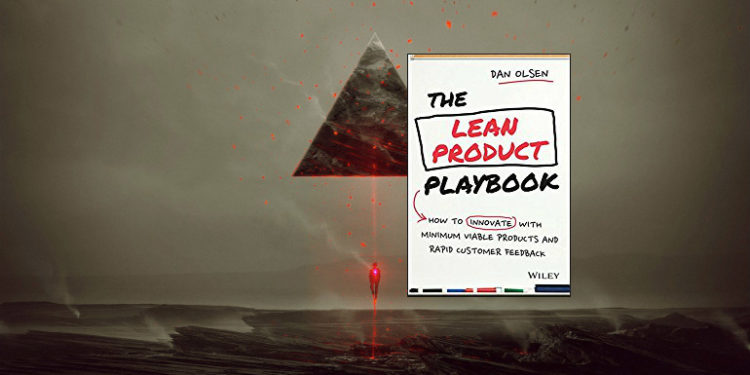The Lean Product Process

Create and validate your hypotheses about your target market and their unmet needs and then do the same with your value proposition, feature set, and user experience. Use the build-measure-learn loop to refine your hypotheses.
The Lean Product Playbook by Dan Olsen
The Lean Product Playbook covers the entire Lean product development process: finding your target market, creating your value proposition, building your minimum viable product (MVP), and establishing the right metrics. Olsen focuses on creating value, rather than capturing it so he doesn’t cover topics like business models, pricing, customer acquisition, or marketing. You’ll find a wealth of useful tools in the book, which is dense with frameworks and concepts.
Olsen’s method is based on two core concepts: product-market fit and problem/solution space. The book includes several in-depth case studies from his experience leading product development at Intuit and Friendster and as a consultant at Cuil, Uber, and Airbnb.
Product-Market Fit
My definition of product-market fit…is that you have to build a product that creates significant customer value. This means that your product meets real customer needs and does so in a way that is better than the alternatives.
A Playbook for Achieving Product-Market Fit by Dan Olsen at Lean Startup Conference from Dan Olsen
The product-market fit pyramid is the core of Olsen’s method. It’s a stack of five testable hypotheses divided between the product (solution space) and the market (problem space). The bottom layer represents the target market and the layer above contains their unmet needs. The lower two layers represent your market: the set of people who share a similar set of needs.
The product consists of the upper three layers: value proposition, feature set, and user experience (UX). The product feature set is initially defined by the minimum viable product (MVP). Olsen shows how to validate each of these layers with user interviews, surveys, and prototypes. The case studies illustrate how customer data based on in-person interviews and surveys can guide companies to revise and refine each of their layers. Product-market fit is a result of matching unmet or underserved needs with the right product (benefits, features, and user experience).
The hypotheses you make in one layer affect all layers above it. Once you’ve locked in your hypotheses for these layers, they are like a set of interconnected tectonic plates. If you move one of them after you’ve already built your product, much of the product you’ve built will no longer be relevant—like an earthquake that reduces a building to rubble.
Problem Space vs Solution Space
A Playbook for Achieving Product-Market Fit by Dan Olsen at Lean Startup Conference from Dan Olsen
Solution space includes any product or representation of a product that is used by or intended for use by a customer. It is the opposite of a blank slate.
Problem space is where all the customer needs that you’d like your product to deliver live.
“What” is problem space and “how” is solution space.
Solution space contains the various competitors to your solution. These can include “do nothing” or workarounds, or doing things by hand. Olsen gives the example of preparing your taxes. One of TurboTax’s biggest early competitors was simply pen and paper.
There are four problem/solution space frameworks which Olsen uses to help describe how you are addressing customer needs: problem/solution space feature mapping, the Kano model, Importance/Satisfaction matrix, and a hierarchy of needs. Each of these help map the problem/solution domain and help prioritize development based on customer needs.
The “what” and “how” dimensions of product development are related to whether you approach your production “inside-out” or “outside-in”. Inside-out products start with ideas and definitions that are created within a company and then brought out to customers to hopefully resonate and gain acceptance. Outside-in products begin with the customer and then are implemented by internal teams.
Related to this, Olsen discusses the two poles of customer orientation: “the customer is always right” and “your customers don’t know what they want”. On the one hand, it’s tempting to think that individual creative powers can discern the right solution; on the other, you can get overwhelmed by insistent customer feature requests. He says that although customers “won’t invent a breakthrough product for you…that doesn’t mean it’s a waste of time to understand their needs and preferences.”
The Lean Product Process
Olsen’s Lean Product Process starts at the bottom of the pyramid and moves upward through the layers:
- determine your target customers
- identify underserved customer needs
- define your value proposition
- specify your minimum viable product (MVP) feature set
- create your MVP prototype
- test your MVP with customers
1. Determine your target customers
Determining your target market involves creating personas, understanding economic buyers versus end-users, and factoring in the technology adoption lifecycle. Segmentation can be done along a variety of attributes including demographic, psychographic, and interests.
2. Identify underserved customer needs
Customer discovery interviews, customer benefit ladders, hierarchies of needs, the importance / satisfaction matrix, and the Kano model are tools which identify underserved customer needs. Using each of these methods to visualize your intended (or current) product will help identify which needs are the best fit for your capabilities and market opportunity.
A Playbook for Achieving Product-Market Fit by Dan Olsen at Lean Startup Conference by Dan Olsen at Lean Startup Conference from Dan Olsen
Plotting customer satisfaction vs importance as percentages supports calculating current value delivered as satisfaction x importance. A feature with a satisfaction score of 50% and importance score of 50% would have a value delivered of (.5 x .5) = .25. Two features can be compared in terms of their opportunity to create value by calculating their upside as Importance x (1 – Satisfaction). This value helps identify how much potential improvement there is if satisfaction becomes 100% for the same importance.
There’s s a detailed description of how to perform survey customers and conduct customer discovery interviews–critical steps in the Lean product development process. An extended case study on marketingreport.com illustrates how customer feedback can be used to change the product offering and learn whether initial hypotheses are correct and/or valuable.
3. Define your value proposition
To decide which features to build, you need to identify the specific customer needs your product should address. In doing so, you want to determine how your product will be better than others in the market. This is the essence of product strategy
After completing the first two steps of the Lean Product Process, determining your target customer and identifying underserved customer needs, you’re ready to define your value proposition before testing it with customers.
Since “strategy is saying ‘no'”, it’s critical to define exactly where you will compete and where you will not invest. Mapping your benefits to must have, delighter, and exciter tiers against competitors allows you to zero in on where you are competing and how you plan to win against other available solutions. Creating the table below for your product makes your positioning and product strategy explicit.
| Feature | Competitor A | Competitor B | You |
|---|---|---|---|
| Must Have Benefit 1 | Yes | Yes | No |
| Must Have Benefit 2 | No | No | Yes |
| Performance Benefit 1 | Yes | Yes | Future |
| Exciter Benefit 1 | No | No | Yes |
| Exciter Benefit 2 | Yes | No | Yes |
This table can be projected forward in time to include a “future” column which both predicts what benefits customers will expect as well as what the competitive space may look like after further investment by you and competitors.
There’s another dimension to consider: level of investment required. Once you understand the customer value, you can map it against your level of effort required. Combining these two attributes gives insight into product decisions.
4. Specify your minimum viable product feature set
In this step, you take your value proposition and definine an MVP with small batches of stories. When creating the MVP prototype, it’s important to select the right type of tests to gain quantitative and/or qualitative data to prove or disprove your hypotheses.
5. Create your MVP prototype
Testing your hypotheses is the objective of building a prototype. Olsen provides a framework of MVP tests (product and marketing vs qualitative and quantitative). Qualitative product tests include wireframes, mockups, interactive prototypes, Wizard of Oz, Concierge, and live product. Quantitative product tests include Fake door, product analytics, and A/B tests.
6. Test your MVP with customers
Testing your MVP requires another set of product management skills. Olsen identifies what questions to ask, how to ask them, and how to schedule and structure the interview process.
Product Metrics
Metrics ROI
The metrics chapters offer both frameworks and practical step-by-step guidance. Olsen introduces the powerful concept of “metrics ROI.” He gives the example of three metrics and needing to decide which metric to prioritize. Each metric in his example drives a business outcome, but each metric has a different amount of change which can be introduced. Using this idea of a metric’s return on investment (ROI), he illustrates that in order to pick which metric to improve first, you need to know how much effort will result in a gain to that metric. Some metrics are hard to move and result in very little improvement. You want to find the metric that moves the most with the least (relatively) amount of effort. He gives several examples from his experience of selecting the right metric in which to invest.
The equation for your business
Starting with the basic equation Profit = Revenue – Cost, Olsen outlines fundamental business equations for advertising and subscription revenue models. He then goes on to elaborate on key metrics including customer lifetime value and customer acquisition cost. These basic equations which drive business outcomes are a great complement to the section on metrics. A key decision for product managers is which metrics to measure, which metrics to improve, and understanding how metrics affect business objectives.






